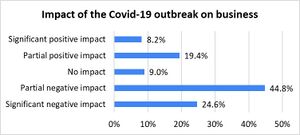Research Agenda
Current state and challenges of XR technologies
The impact of Covid-19 on XR in Europe
The Covid-19 pandemic has unleashed adverse impact on the global business. The lockdown in almost all countries severely affected the ways companies do business and operate. Even though the crisis is persisting, it will likely generate long-term trends resulting from increased need to digitalise businesses and processes to face the Covid-19 restrictions (travel restrictions, remote work, distancing, etc.). To understand the impact of the Covid-19 pandemic on XR businesses, XR4ALL conducted a survey in May 2020, which received 134 responses from different types of stakeholders (see section 3.2.2). Asked about how they would scale the general impact of the Coronavirus outbreak on their business or businesses in their network/portfolio, respondents gave diverse answers ranging from significant negative impact to significant positive impact. Figure 25 shows that only 24.6% had a significant negative impact and for the remaining respondents, 44.8% indicated that they had partially negative impact and 19.4% had rather partial positive impact and 8.2% significant positive impact. Thus, in the XR industry, the impact on XR businesses is not too severe, as more than 75% of the respondents stated, the impact was not significantly negative and for 27.6% of the respondents, the impact is rather positive. The coronavirus pandemic is perceived to provide a boost for the XR industry.
Major progress
General trends
XR technologies will enter all fields of our daily life, either private or in the corporate setting. The most relevant domains are: repair, maintenance, immersive training, inspection and quality assurance, design, and assembly. However, the entertainment and film industry are entering this domain as well and VR becomes a standard in entertainment and education. For the above mentioned domains, new business models are possible. For remote assistance scenarios, XR technologies lead to increased efficiency, time saving with regards to travel and shorter time for repair and maintenance. Multi-modal and multi-user interaction scenarios are available, which broadens the applicability in a wide range of domains. These changes as well as real-time and low-latency streaming will further create interest for the digital transformation, especially for employees.
